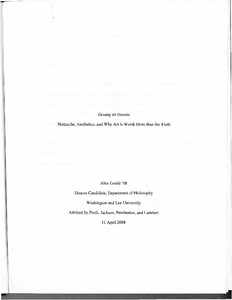| dc.description.abstract | What, then, are we to make of Nietzsche's exaltation of art? The goal of this study is to examine why Nietzsche might have declared art to be worth more than the Truth and, with sufficient prudence so as not to attempt to define or simplify where definition and simplification are impossible (as is the case with much of his thought), to place Nietzsche's thoughts on aesthetics among the other elements of his philosophy, including his ethics. We shall begin with a journey back in time to the land of Oedipus and Socrates and, from there, trace the evolution of that genre most palatable to both artists and philosophers -- tragedy -- so as to arrive at a better understanding of how Nietzsche's thought about art is fundamentally emergent from Platonism. Next, we shall embark on three critiques: first, of logical positivism, by which we shall see how science and logic necessarily give birth to art; second, of Kant's and Schopenhauer's theory of
disinterestedness, contra Nietzsche's notion of an "active" aesthetic state characterized by Rausch ("rapture"), the Dionysian, and what Stendhal termed "une promesse de bonheur"; and, third, of the Aristotelian concept of catharsis, by which we shall consider art's ability not to purge us of the horrible truths of existence but to bring them to light. This new understanding of catharsis shall, in tum, compel us to consider Nietzsche's seemingly outlandish statement about art as an artistic statement itself and, subsequently, explore whether we might not learn more about ourselves -- whether we might not be better poised to reach the truly deep recesses of the soul -- through our interactions with fiction than with Truth; and, then, lastly, in the final chapter, we shall return to that most "raging" of discordances and, having by this time explored it from several perspectives, attempt to lay down as precisely as possible the reasoning behind Nietzsche's shocking verdict in the case of Art v. Truth and, with this in mind, point out to the philosopher immobile before his three Sirens his proper path and kindly see him on his way. [From Introduction] | en_US |
| dc.rights | This material is made available for use in research, teaching, and private study, pursuant to U.S. Copyright law. The user assumes full responsibility for any use of the materials, including but not limited to, infringement of copyright and publication rights of reproduced materials. Any materials used should be fully credited with the source. | en_US |
